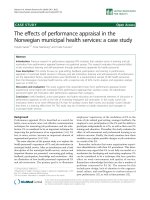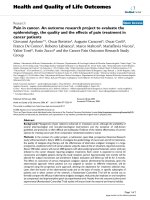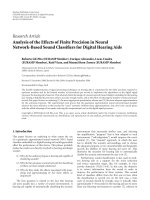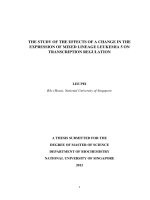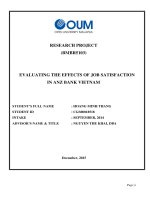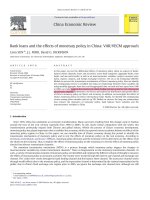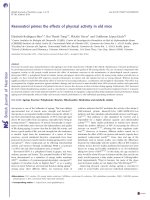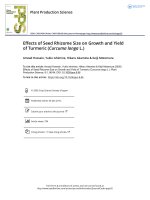The effects of waterlogging at germination stage on growth and yield of soybean genotypes in winter cropping season 2020
Bạn đang xem bản rút gọn của tài liệu. Xem và tải ngay bản đầy đủ của tài liệu tại đây (3.13 MB, 94 trang )
VIETNAM NATIONAL UNIVERSITY OF AGRICULTURE
FACULTY OF AGRONOMY
UNDERGRADUATE THESIS
TITLE: THE EFFECTS OF WATERLOGGING AT
GERMINATION STAGE ON GROWTH AND YIELD
OF SOYBEAN GENOTYPES IN WINTER
CROPPING SEASON 2020
Student
: Nguyen Thi Hai Yen
ID code
: 605280
Class
: K61KHCTT
Instructor
: PhD. Nguyen Van Loc
Department
: Food crop
HA NOI - 2021
COMMITMENT
I hereby declare that this is my own research, the data and research results
in this report are truthful and have not been used to defend a degree.
I hereby certify that all assistance in the implementation of this graduate
research project has been thanked and the information cited has been indicated
by the origin, name of the author, time of publication.
Ha Noi, February 25th, 2021
Student
Nguyen Thi Hai Yen
i
ACKNOWLEDGEMENTS
To complete this thesis, I am deeply indebted to people who have been
providing me with precious support and advice.
First of all, I would like to express my gratitude to the Dean of the Faculty
and the teachers in the Faculty of Agriculture, especially the teachers in the
Food Crops subject for facilitating help and having many valuable ideas to help
me complete this graduation thesis.
Secondly, I would like to send my gratitude to my instructor, Ph.D
Nguyen Van Loc, Department of Food Crop, Faculty of Agronomy, Vietnam
National University of Agriculture, for their enthusiastic support, helpful advice
and considerable encouragement in the completion of my thesis.
I would also like to express sincere thanks to M.S Tran Thi Minh Ngoc
from Department of Food Crop and all the lectures from Faculty of Agronomy,
who taught and created best conditions for students during learning process and
research.
Last but not the least, I would like to thank my family and my friends who
have alwaay beens by my side, give me support and strength to complete this
graduattion thesis.
I sincerely thank you!
Hanoi, February 25th , 2021
Student
Nguyen Thi Hai Yen
ii
CONTENTS
COMMITMENT ............................................................................................................. i
ACKNOWLEDGEMENTS ........................................................................................... ii
CONTENTS .................................................................................................................. iii
LIST OF ABBREVIATIONS ....................................................................................... vi
LIST OF TABLES........................................................................................................ vii
LIST OF PICTURES, FIGURES ................................................................................ viii
ABSTRACT .................................................................................................................. ix
CHAPTER 1: INTRODUCTION ................................................................................1
1.1. Rationale ...................................................................................................................1
1.2. Aims and requirements .............................................................................................3
1.2.1. Aims.......................................................................................................................3
1.2.2. Requirements .........................................................................................................3
CHAPTER 2: LITERATURE REVIEW ....................................................................4
2.1. Origin and distribution of soybeans .........................................................................4
2.2. Values of soybeans ...................................................................................................4
2.2.1. The nutritional value ..............................................................................................4
2.2.2. Value increase the crop, improve the agricultural environment ...........................6
2.2.3. The industrial value ...............................................................................................7
2.2.4. The medical value ..................................................................................................7
2.3. Soybean production in the world and Vietnam. .......................................................8
2.3.1. Soybean production in the world ...........................................................................8
2.3.2. Soybean production in Vietnam ..........................................................................10
2.4. Physiological requirements of soybean plants .......................................................12
2.4.1. Soil requirements .................................................................................................12
2.4.2. Humidity requirements ........................................................................................12
2.4.3. Temperature requirements ...................................................................................13
2.4.4. Light requirements ...............................................................................................13
2.5. Soybean growth and development characteristics ..................................................14
iii
2.5.1. Vegetative stage ...................................................................................................15
2.5.2. Reproductive stage(R) .........................................................................................16
2.6. Overview of research on the effects of inundation on soybean yield in the country
and in the world. ............................................................................................................17
2.6.1. Effects of inundation on soybean production ......................................................17
2.6.2. Research situation of the effect of the flood on the development of soybean
plants in the world. ........................................................................................................18
2.6.3. Research situation of the effect of the flood on the development of soybean
plants in Viet Nam. ........................................................................................................20
CHAPTER 3: MATERIALS AND METHODS .......................................................22
3.1.Plant materials .........................................................................................................22
3.2. Experimental design ...............................................................................................22
3.3. Cultural practices ....................................................................................................23
3.4. Research content .....................................................................................................24
3.5. Trait observation .....................................................................................................24
3.5.1. Qualitative traits ..................................................................................................25
3.5.2. Quantitative traits ................................................................................................25
3.6. Growth and development indicators .......................................................................25
3.7. Productivity components ........................................................................................26
3.8. Data analysis ...........................................................................................................26
CHAPTER 4: RESULTS AND DISCUSSION .........................................................27
4.1. Germination rate of soybean genotypes in winter cropping system 2020. ...........27
4.2. Vegetative traits of soybean genotypes ..................................................................28
4.2.1. Plant height dynamic of soybean genotypes .......................................................28
4.2.2. The number of trifoliate leaves dynamic of soybean genotypes .........................31
4.2.3. The number of branches per plant dynamic of soybean genotypes. ...................34
4.2.4. The number of node dynamics of soybean genotypes. .......................................36
4.2.5. Some growth characteristics of soybean genotypes ............................................38
4.3. The dry matter of soybean varieties after harvesting .............................................41
4.4. Components of productivity and yield of soybean genotypes ..............................43
iv
4.4.1. Components of productivity of soybean genotypes ............................................43
4.4.2. Yield of soybean genotypes. ................................................................................47
CHAPTER 5: CONCLUSIONS AND SUGGESTIONS .........................................54
5.1. Conclusions ............................................................................................................54
5.2. Suggestions .............................................................................................................55
REFERENCES ..............................................................................................................56
APPENDIX ...................................................................................................................59
v
LIST OF ABBREVIATIONS
C
: control
CV
: coefficient of variation
LSD
: Least significant difference
W
: waterlogging
vi
LIST OF TABLES
Table 2.1 Nutritional value per 100g soybean seeds ....................................................... 5
Table 2.2 Soybean production in Vietnam from 2014 to 2018 ..................................... 11
Table 2.3 Humidity and rainy requirements of soybean plant for each of stages ......... 13
Table 2.4 Temperature requirements for each of soybean stages ................................. 13
Table 2.5 Impact of flooding stress on different growth stages of a soybean crop ....... 19
Table 3.1 Soybean genotypes used for experiment in winter cropping systems ........... 22
Table 4.1 Germination rate of soybean genotypes ........................................................ 27
Table 4.2 Plant height dynamic of soybean genotypes ................................................. 29
Table 4.3 The number of trifoliate leaves dynamic of soybean genotypes ................... 31
Table 4.4 The number of branches per plant dynamic of soybean genotypes. ............. 34
Table 4.5 The number of node dynamic of soybean genotypes. ................................... 37
Table 4.6 Some growth characteristics of soybean genotypes ...................................... 39
Table 4.7 The dry matter of soybean genotypes after harvesting. ................................ 41
Table 4.8 Components of productivity of soybean genotypes ...................................... 43
Table 4.9 Components of productivity of soybean genotypes ...................................... 44
Table 4.10 Yield of soybean genotypes. ....................................................................... 48
vii
LIST OF PICTURES, FIGURES
Picture 2.1 World soybean production from 2000-2020 ................................................. 8
Picture 2.2 Vegetative stage of soybean ........................................................................ 15
Picture 2.3 Reproductive stages of soybean .................................................................. 16
Fig 3.1 Waterlogging and control treatment when soybeans were in germination
stage. ........................................................................................................... 23
Fig 4.1 Variation in the plant height of soybean genotypes under waterlogging.
Vertical bars indicate SEM ........................................................................ 30
Fig 4.2 Variation in the number of trifoliate leaves of soybean genotypes under
waterlogging(A) and control condition (B). Vertical bars indicate SEM ...... 33
Picture 4.1 Soybean genotypes under control(A), and waterlogging conditions(B) in
the flowering stage. .................................................................................... 34
Fig 4.3 Variation in the number of branches per plant of soybean genotypes under
waterlogging(A), and control conditions(B). Vertical bars indicate
SEM ............................................................................................................ 36
Fig 4.4 Variation in the number of node of soybean genotypes under waterlogging.
Vertical bars indicate SEM ........................................................................ 38
Fig 4.5 The dry matter of soybean genotypes after harvesting. Bars genotypes are
significantly different at P<0.05................................................................. 42
Picture 4.2 TT2(A), and D8(B) genotype when harvesting .......................................... 47
Fig 4.6 The individual yield of soybean genotypes. Bars genotypes are significantly
different at P<0.05. ..................................................................................... 51
Fig 4.7 The actual yield of soybean genotypes. Bars genotypes are significantly
different at P<0.05. ..................................................................................... 52
Fig 4.8 The theoretical yield of soybean genotypes. Bars genotypes are
significantly different at P<0.05................................................................. 52
viii
ABSTRACT
The aims of the graduation thesis are evalution the effects of waterlogging at
germination stage on growth and yield of soybean genotypes in the winter cropping
system 2020, and selecting varieties with good flood tolerance for research and
plant breeding. The experiment was arranged at the experimental field of the
Faculty of Agronomy in VNUA. Five soybean genotypes, including HSB0059,
DT84, TT2, D8, LSB17-21-12-15 were used in this study. The experimental design
was got the result by 3 random plants in each genotype and 2 formula
(waterlogging and control experiment), and RCD. We planted 6 beds, 3 beds under
waterlogging condition, and 3 beds under control condition. Waterlogging
conditions when soybeans were germinating. The results of this study show that the
germination rate under waterlogging conditions was greatly reduced by 25%.
However, compared to control conditions, vegetative traits and yield of soybean
varieties under waterlogging conditions were reduced. The actual yield under
waterlogging conditions varied from 9.9 to 32.9 quintals/ha while it varied from
11.8 to 38.2 quintals/ha under control conditions. HSB0059 variety had the highest
germination rate, and yield under two conditions. Further experiments to evaluate
the inundation effects on soybean growth and yield under rice conditions in winter
cropping systems should be further conducted to come to more accurate
conclusions. HSB0059, TT2, LSB17-1-12-15 had high germination rate and high
yield and adapted under waterlogging conditions. It is necessary to do more
experiments to evaluate other criteria to put into production in production areas
with unfavorable conditions in production.
ix
CHAPTER 1: INTRODUCTION
1.1. Rationale
Soybean Glycine max (L.) Merrill belongs to the legume family. Soybean
has been grown for three millennia in Asia and more recently, has been
successfully cultivated around the world. Today, the world’s top producers of
soybean are the United States, Brazil, Argentina, China and India.
Soybean is a short-term industrial plant, which has many values in many
aspects: supplying protein, vegetable oil for humans, animal feed, raw material
for some industries, and improving soil fertility. Soybean is an economically
important legume seeds contain an average of 40% protein and 20% oil, and its
plants enrich the soil by fixing nitrogen in symbiosis. In the international world
trade markets, soybean is ranked number one in the world among major oil
crops ( Chung and Singh 2008). Moreover, soybean seed also contain iron,
calcium, phosphorus and fiber components for digestion. Vitamins in soybeans
are abundant in group B such as vitamin B1, B2, B6. Soybean oil, used in food
and industrial applications, is another product. . In the United States, the bulk of
the harvest is solvent-extracted with hexane, and the “toasted” defatted soy meal
(50% protein) then makes possible the raising of farm animals (e.g chicken, hog,
turkey) on a large industrial scale. Therefore, soybean has become one of the
most important crops in agricultural production in many countries around the
world.
Soybean plant (Glycine max (L) Merrill), belonging to the legume family
(Fabaceae) are able to fix the unused plant nitrogen molecule nitrogen into
usable nitrogen form by the rhizobium in the roots. In order to meet the need for
high efficiency in soybean production, the first condition is that the seedling is
good before planting, conditions that affect the germination of the seed such as
temperature, oxygen concentration, and weak otherwise, the water level factor is
1
the important factor affecting the appearance and development of the seed
(Pollock, 1972). Depending on the planting season, the seed may experience
cool, sunny, or rainy weather after planting the seed is wet, or weather without
proper water, in which case the seed may be submerged for a number of hours or
several days. Inundation or saturation of the soil can cause poor seed
germination and planting and may decrease crop yields.
Around the world, research on the effects of waterlogging tolerance of the
soybean plant is new research. Research works are often focused mainly on
evaluating the ability to grow and develop. According to research by Sung
(1995), soybean seeds that were submerged before germinating for 24 hours
only reached 50% germination and did not soften after flooding for 48 hours. In
humid parts of the world, waterlogging is a major environment stress limiting
soybean production (Kokubun etal., 2013). In inhibits growth and seed yield,
leading to decreased root growth, nitrogen fixation, leaf chlorophyll content, and
growth, and photosynthesis activity (Scott et al., 1989; Oosterhuit et al., 1990;
Sung, 1993; Linkemer et al., 1998; Bacanamwo and Purcell, 1999; Pedo et al.,
2015; Suematsu et al., 2017). Therefore, breeding varieties with strong
waterlogging-tolerance is a desirable trait in countries with much rainfall(Van
Nguyen et al., 2017).
In Vietnam, soybean is widely cultivated in all 7 ecological regions in the
whole country. In which, the Northern midlands and mountains are the largest
sowing area. Soybeans are very suitable in rotation, intercropping, pillow crop
with many other crops contribute to increasing crop yield and improving landuse efficiency. This issue is very implications for increased crop intensification
in our country. Rainfall is one of the most significant factors required for the
proper growth and development of crop plants, particularly in developing
countries. However, an excessive amount of rainfall has its impact in the form of
flooding, which has severe impact on the growth of crop plants, including
2
soybean crops cultivated in rain-fed regions. Flooding stress causes significant
damage to the morphological and physiological features of soybean crops and
hence reduces grain yield severely. Soybeans often planted in winter cropping
system are affected by rainfall than those conventional planted in spring-summer
season in Northern. Therefore, productivity and quality of soybean Viet Nam is
low.
Currently, our country is one of the most affected countries. Climate
change causes drought, soil salinity, and waterlogging - severely affecting plant
growth, development, and productivity. Therefore, the research on the tolerance
of inundation of plants in general and soybean, in particular, is urgent and has
high applicability. The results of this study serve as the basis for further studies
and for the selection of soybean genotypes that are resistant to inundation.. So
that, to contribute to solving the above problem, we carried out the subject” The
effects of waterlogging at germination stage on growth and yield of soybean
genotypes in winter cropping season 2020”.
1.2. Aims and requirements
1.2.1. Aims
This study aims evaluate the effects of waterlogging at germination stage
on growth and yield of soybean genotypes in winter cropping season 2020.
1.2.2. Requirements
- Evaluation of some morphological and agro-biological characteristics of
soybean varieties in winter cropping.
- Evaluate the growth and development of soybean
- Determine the factors constituting the yield and yield of the sample soybean
variety.
3
CHAPTER 2: LITERATURE REVIEW
2.1. Origin and distribution of soybeans
Soybean (Glycine max. L. Merr) belongs to the legume plant (Fabaceae),
originated from Northeast Asia (China), known for 5,000 years. Soybean has
been cultivated since 1,100 BC. Soybean is widely distributed, from 480 North
to 300 South latitude, closely reacting to day length and is a typical short-day
crop. From the North of China, soybeans were developed to Japan, Korea, East,
and South China, Southeast Asian countries including Vietnam. In the 17th
century, soybeans were introduced to Europe …
According to Le Quy Don's book "Van Dai loai ngu", Vietnam has a
history of soybean cultivation from the 6th century, originally planted in the
northern mountainous areas of Cao Bang and Lang Son. Soybeans are used to
make tofu, soy sauce, sauces, oils, milk, and flour in some foods and
confectionery. Before the August Revolution, the soybean area reached 30,000
hectares, the yield reached 4.1 quintals/ha. After 1973, our country had only
significant development in soybean production. By 1983, the soybean area had
increased to 106 thousand hectares, yield 5 - 9 quintals/ha.
2.2. Values of soybeans
2.2.1. The nutritional value
- According to an analysis by the US Department of Agriculture (USDA)
4
Table 2.1 Nutritional value per 100g soybean seeds
Nutritional value per 100g soybean seeds
1,866 kJ (446 kcal)
Energy
30,16 g
Carbohydrat
Sugar
7,33 g
Dietary fiber
9,3 g
Lipid
19,94 g
Saturated fat
2,884 g
Monounsaturated fat
4,404 g
Polyunsaturated fats
11,255 g
36,49 g
Protein
Tryptophan
0,591 g
Threonin
1,766 g
Isoleucin
1,971 g
Leucin
3,309 g
Lysin
2,706 g
Methionin
0,547 g
Cystin
0,655 g
Phenylalanin
2,122 g
Tyrosin
1,539 g
Valin
2,029 g
Arginin
3,153 g
Histidin
1,097 g
Alanin
1,915 g
Axit aspartic
5,112 g
Axit glutamic
7,874 g
Glycin
1,880 g
Prolin
2,379 g
Serin
2,357 g
Water
8,54 g
Vitamin A equiv,
1 μg (0%)
Vitamin B6
0,377 mg (29%)
Vitamin B12
0 μg (0%)
Vitamin C
6,0 mg (10%)
Vitamin K
47 μg (45%)
Canxi
277 mg (28%)
Iron
15,70 mg (126%)
Magie
280 mg (76%)
Phospho
704 mg (101%)
Potassium
1797 mg (38%)
Natri
2 mg (0%)
Zinc
4,89 mg (49%)
Note! Ratio(%) the daily needs of adults
Source: USDA database
5
- According to other sources of analysis
In soybean seeds, there are chemical components: Protein (40%), lipid (1225%), glucid (10-15%); There are mineral salts Ca, Fe, Mg, P, K, Na, S; vitamins
A, B1, B2, D, E, F; enzymes, wax, resin, cellulose. In soybean, there are enough
basic amino acids such as isoleucine, leucine, lysine, methionine, phenylalanine,
tryptophan, valine. In addition, soybeans are considered to be a complete protein
source because they contain significant amounts of non-essential amino acids for
the body.
Soy-based foods are considered a type of "boneless meat" because they
contain abundant plant protein, which can be substituted for protein from animal
meat. Even the amount of protein in 100 grams of soybeans can be equivalent to
the amount of protein in 800 grams of beef.
In countries such as Japan, China, 60% of the daily protein intake comes
from soybeans. The protein content of soybeans is much higher than the amount
of protein contained in other beans.
2.2.2. Value increase the crop, improve the agricultural environment
Soybean plants have the ability to fix nitrogen from the air through the root
nodule system, soybean roots are branched to make the soil more porous,
improve the soil, and soybean leaf stalks make green manure. Estimate per
hectare, after planting, soybean remains in the soil about 30 kg, equivalent to
urea nitrogen and 5-8 tons of organic matter. In recent years, the growers of
high-class fruit and ornamental plants have used a lot of soybean seeds and
soybean meal to care and fertilize the plants with high results.
Soybean rotation with other crops has the effect of balancing soil nutrients,
contributing to cutting off pest lines in rotation, minimizing the use of harmful
chemicals for the environment, leaving residues of toxic substances for
agricultural products.
6
Experienced farmers realize that after each crop, soybean yields higher
yields, fewer pests and diseases, and saves 30% of fertilizer. In the provinces of
the Red River Delta, the rice yield here increased significantly compared to the
formula of 2 rice crops + 1 winter corn crop, soil quality improved more clearly.
2.2.3. The industrial value
Soybean is the raw material of many different industries such as the
processing of artificial rubber, paint, printing ink, soap, plastics, rayon, liquid fuels,
lubricants in the aviation industry, but weak soybeans are used to squeeze oil.
Currently, in the world, soybean is the leading plant in supplying raw materials for
oil press, soybean oil accounts for 50% of total vegetable oil. Characteristics of
soybean oil: slow drying, high iodine index: 120-127; Condensation at
temperatures: - 15 to - 18 0 C. From this oil, people make hundreds of other
industrial products such as candles, soap, nylon, etc.
2.2.4. The medical value
Soybean is one of the precious medicinal herbs. Soybeans have long been
known as a food with high nutritional value because of their higher protein
content than any other agricultural product. Moreover, soybeans also contain a
lot of minerals, B vitamins, especially herbal chemicals that have the ability to
prevent and treat diseases. In recent years, soybeans have been transformed from
food to medicine. Soybeans and dishes made from soybeans also have
preventive and curative values. Soybean works to make the human body long,
energetic, increase memory and regenerate tissues, harden bones, and increase
the body's resistance. In medicine, soybean meal (which has lost its smell by
steam) is mixed with cereal flour, cocoa is used as food for babies, people with
diabetes, people with rheumatism, gout, overworked workers.
In the pharmaceutical industry, soybean meal is used to process antibiotic
mold culture medium, and to process some amino acids such as arginine,
glutamic acid by hydrolysis of soybean acid. Scientists also discovered that
7
soybean herb has properties against cancer germs such as breast cancer, colon
cancer, lung cancer, stomach cancer, prostate cancer.
2.3. Soybean production in the world and Vietnam.
2.3.1. Soybean production in the world
Soybean is a short-term crop that is widely grown and is one of the most
nutritious and economical crops in the world. Typically countries such as,
America, Brazil, Argentina. China, India. Their soybean production accounts for
90-95% of world production, according to USAA’s 2008 US soybean output at
33%, followed by Brazil at 28% and Argentina at 21%. Soybean all over the
world. Soybeans occupy the most important positions in eight of the world’s
most important crops: soybean, peanut, cotton, sunflower, canola and coconut.
Soybean is grown in almost all countries in the world, with 73% in the
American, followed by Asia (China, India), accounting for 23.15%. In recent
years, world soybean production has gradually increased and is shown in the
following chart:
Picture 2.1 World soybean production from 2000-2020
According to the US Department of Agriculture (USDA), in May 2020, the
world soybean production 2020/2021 is estimated to be 362.76 million tons.
8
Soybean production last year (*) was 336.11 million tons, this year's 362.76
million tons estimated to increase by 26.64 million tons or 7.93% of global
soybean production.
In addition to the four countries (USA, Brazil, Argentina, China) that
produce the world's largest soybeans, Japan is also a long-standing soybean
producer. The soybean plant was introduced to Japan about 200 BC, but it
wasn't until 1960 that it started to develop (Nogato, 2000). In 1960, the soybean
area of this country was only 340,000 ha, but by 1997 it reached 832,000 ha
(Nguyen Van Luat, 2005).
Southeast Asia is a limited soybean production region but imports a lot of
soybeans and increases each year (source USDA, 2010). In 2003, the region was
the largest soybean importer with nearly 3.5 million tons of soybean meal and 3
million tons of soybeans. In which, Indonesia produces about 800,000 tons/year
of soybeans and imports 1.4 to 1.5 million tons, Thailand produces 600,000 to
700,000 tons/year of soybeans. In 2002, Thailand imported 1.3 million tons of
soybeans and 1.9 million tons of soybean meal. The Philippines has very little
soybean production, but its three millers import about 350,000 tons of soybeans,
and 1.25 million tons of meals are imported. Vietnam also has a small local
production, but its booming food industry imported 600,000 tons of soybean
meal in 2002. Vietnam is the only country in the region to see the growing
demand for two numbers.
In general, the world's soybean production in recent years has developed
strongly due to its nutritional and economic value. The increase in yield and
yield of soybeans is due to many factors, the most influencing factor is variety,
which is the reason why people have been focused on developing soybean
varieties from the past. The application of technical advances, intensive farming
in production, and the use of advanced technical methods in soybean breeding
9
research have made soybean acreage, productivity, and yield increase gradually
throughout the year.
2.3.2. Soybean production in Vietnam
In Vietnam, soybean is a food plant with a long and important tradition,
providing protein mainly for humans, and is an indispensable component of
traditional and modern meals. Before the 80s of the last century, soybean yield in
Vietnam was still low due to the old breeds and outdated cultivation techniques.
Vietnam has a history of cultivating soybeans for thousands of years, but
our soybean growing area accounts for only a very small part of the total
cultivated area, about 1.5-1.6% (Pham Van Thieu, 2000). Previously, soybean
production was concentrated in a small scale in the northern mountainous
provinces such as Cao Bang, Lang Son, Before the August Revolution, the
soybean area of the country was about 32200 ha; the yield is 4.1 quintals/ha.
After the August method, our State has paid attention to boost soybean
production, but the result is not high. Since 1973, soybean production began to
have significant developments (Doan Thi Thanh Nhan et al., 1996). The national
soybean area after reunification is 39,954 ha with a yield of 5.2 tons/ha (Ngo
The Dan et al., 1999).
According to the Vietnam Institute of Agricultural Science and Technology,
Vietnam's soybean area is not stable, domestic soybean production is only enough
to supply about 8–10% of demand, by 2017, soybean planting area all over the
country reached about 100 thousand hectares, yield about 1.57 tons/ha, production
reached 157 thousand tons. In 2018, the country's soybean area reached 105
thousand hectares, the average yield of 1.6 tons/ha, the output of 168 thousand
tons.(Table 2.2)
10
Table 2.2 Soybean production in Vietnam from 2014 to 2018
Criteria
2014
2015
2016
2017
2018*
Area (thousand ha)
110.2
100.8
94
100
105
Production (tons/ha)
1.43
1.45
1.57
1.57
1.6
157.9
146.4
147.5
157
168
Total
production
(thousand
tons/ha)
(Source: General Statistics Office (GSO), Ministry of Agriculture and Rural
Development, * Forecast of Post)
Based on the table we see, the soybean cultivated area of our country over
the years has many changes. In general, from 2014 to 2018, the planted area
tends to decrease gradually from 200,000 hectares (2014) to 105,000 hectares
(2018). But in addition, productivity tends to gradually increase from 1.5 tons/ha
(2014) to 1.8 tons/ha (2018) because the work of selecting, creating, and
researching high yielding varieties is increasingly developed. , apply science and
technology to production.
Currently, the country has formed 7 soybean production regions, of which 4
main regions are: the Southeast has the largest area, accounting for 26.2% of the
country's soybean area, mountainous areas and Northern Midlands 24.7%, Red
River Delta 17.5%, Mekong River Delta 12.4%. The total area of these four
regions accounts for 66.6% of the country's cultivated area, the rest is the coastal
plains of Central Vietnam and the Central Highlands (Ngo The Dan et al., 1999).
In the four main production regions above, the Mekong River Delta, although
small in area, has the highest productivity in the country, the average yield of the
whole region is 18.8 quintals/ha, especially in some places in the country. the
area yielded 30 quintals/ha (Pham Van Bien et al, 1976). In the Southeast,
soybeans are concentrated mainly on the red soil of Dong Nai province.
Although the cultivated area is not large, it accounts for 1/3 of the country's
soybean production (Pham Van Thieu et al., 2000). In terms of yield, only 3
11
regions: Red River Delta, Southeast, and Mekong River Delta account for more
than 60% of the country's soybean production Soybean grown in spring crop
accounts for 14.2% of the area, summer crop. it was 2.68%, the SummerAutumn season 31.3%, the Autumn-Winter crop 22.1%, and the Winter-Spring
crop 29.7% (Ngo The Dan et al., 1999).
Overall, soybean production scale is still very small compared to other
crops and much lower than domestic demand, as well as compared with the
GoV's 2020 target outlined in " The plan for agricultural and rural development
for the 2016–2020 period "is 265 thousand tons of soybeans on a cultivated area
of 166 thousand hectares. The report estimates this lack of growth due to low
yields, lack of expansion in growing areas, and poor competitiveness with other
crops make farmers less salty. Therefore, we must take measures to expand the
planted area while improving the yield of soybean varieties to meet production
and consumption needs.
2.4. Physiological requirements of soybean plants
2.4.1. Soil requirements
- Soybean plants can be adapted to many different types of soil, but the best
soil is loam, sandy soils, well-drained, weed-free, not suitable for sandy, rocky,
acidic soils, poor drainage. A pH of 5.2 - 6.5 is the most suitable for soybeans to
grow.
- According to Doan Thi Thanh Nhan et al. (1996), soybeans can still be
grown on basalt red soil, upland land, hilly land. On heavy loam soil, soybeans
are difficult to grow, but when they regrow, they are quite adaptive. In sand soil,
soybean yield is not stable.
2.4.2. Humidity requirements
Although soybean is upland, water is also one of the important needs and
also one of the major limiting factors to soybean production. During the entire
growing process from sowing to harvest, soybeans require between 350 and 400
12
mm to 600 mm of rain. The water efficiency of soybean is 600 - 1000g water /
1g dry matter (Doan Thi Thanh Nhan et al., 1996).
Table 2.3 Humidity and rainy requirements of soybean plant for each of
stages
Stage
Humidity and rainy requirements
Humidity (%)
Germination
75- 80
Young plant
50- 60
Flowering
70- 80
Ripening
35- 50
Amount of rain (mm)
350- 600
2.4.3. Temperature requirements
Soybeans are temperate, but not a cold-tolerant, crop. Depending on the
early or late-ripening variety, the total area of temperate fluctuates from 1,888 to
2,700 °C; Each stage of growth and development of soybean plants has different
temperature requirements.
Table 2.4 Temperature requirements for each of soybean stages
Stage
Temperature requirement (oC)
Suitable
Lowest-Highest
Germination
18- 22
10- 40
Branching
20- 23
15- 37
Flowering
22- 25
15- 35
Fruiting
21- 23
15- 35
Ripening
19- 20
25- 37
2.4.4. Light requirements
Soybeans are short-term plants that are very sensitive to light. A prerequisite
for high yield of soybeans is to have the highest photosynthetic efficiency. So it
13
is necessary to take good care of the beans to quickly cover the soil, the plants
can absorb maximum light. Soybeans respond to day length, different varieties
react to different day lengths.
According to Doan Thi Thanh Nhan et al., 1996 light has a profound effect
on soybean morphology, it changes the flowering and ripe time, affects plant
height, leaf area, and many other properties. of the tree, including seed yield.
During all stages of true growth, flower bud formation is believed to be less
susceptible to cyclic photosensitivity. The first flower buds form both at 16
hours and at 10 hours. However, later flower bud development is very slow
under long-day conditions and the time to flower can be doubled. First, the
flower buds appear on the meristem at an axillary of the leaves on the stem and
then towards the tip, base, and branch. If the number of short days is not enough,
the flowers show only a few segments on the main stem, while the remaining
segments and the tip continue to proliferate. In contrast, under continuous shortday (10-12 h) conditions, the flowers bloom very quickly within 7- 10 days, the
tops of varieties with limited growth habit also flower. In long-day conditions
(14-16 h) the first flower buds appear as soon as the lighting time is 10-12h.
Day length also affects the fruiting rate and fruit growth rate. Short days
increase the rate of beans and speed of dry matter accumulation in the fruit.
After flowering, if having long-term conditions, high air temperature, soybeans
lose fruit, few seeds. In Vietnam, soybean varieties are divided into 3 groups:
early ripening group, medium ripening group, and late-ripening group. Early
ripe varieties with little response to day length should be planted in all 3
seasons, while late ripe varieties have a clear response, so there must be a
reasonable crop arrangement (Doan Thi Thanh Nhan et al., 1996).
2.5. Soybean growth and development characteristics
It is divided into two phases: vegetative (V) and reproductive (R). In the
first stage is the growth of vegetative (roots, stems, leaves); in the second stage,
14
it is transformed to form reproductive stage and reserves such as flowers, fruits,
seeds ...
2.5.1. Vegetative stage
Picture 2.2 Vegetative stage of soybean
VE: Vegetative emergence; VC: Vegetative cotyledon;
V1: Single leaf and true leaf bud (3-lobed leaves).
V2: First single leaf and 2 true leaves develop to full size
V3: The first single leaf and the first 3 real leaves grow to full size
V (n): Single leaf and full-grown (n) true leaves
The period from sowing to growing (VE - VC):
This period begins from when the water-absorbent seed swells until the
plant has two cotyledons. This time depends on external conditions such as
temperature, soil moisture, and grain quality. The summer crop in this period is
about 4-5 days in the right humidity conditions. If the temperature is low,
making this time longer can be up to 7-10 days. The suitable temperature for this
period is 260 - 300C. If the temperature is higher than 400, it affects seedlings
and if the temperature is lower than 80 will cause the seed to grow longer. The
growing period must be sufficiently humid, require moisture in this period from
15
